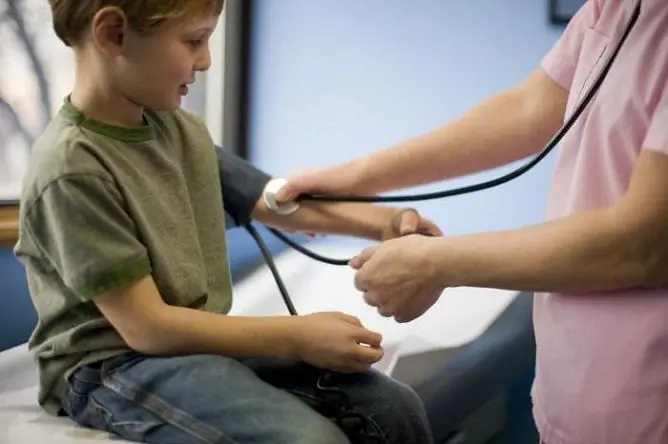Table of contents:
- Blood sugar rate in children: table and decoding
- Determination of blood sugar in children
- Normal blood sugar levels in children
- At what age should blood sugar control in children
- Hyperglycemia and diabetes mellitus in children
- Hypoglycemia

Video: The Norm Of Blood Sugar In Children: Table, The Norm In Children 6 Years Old, 7 Years Old

2024 Author: Rachel Wainwright | [email protected]. Last modified: 2024-01-15 19:51
Blood sugar rate in children: table and decoding
The content of the article:
- Determination of blood sugar in children
- Normal blood sugar levels in children
- At what age should blood sugar control in children
- Hyperglycemia and diabetes mellitus in children
- Hypoglycemia
The blood sugar level in children is one of the main indicators of health. For this reason, the determination of blood glucose is one of the most important studies that are recommended to be carried out regularly in order to diagnose possible diseases at an early stage of their development.

Blood sugar tests in children should be done regularly
Glucose is a monosaccharide, the main source of energy in the body, providing metabolic processes. The amount of glucose in the blood is a marker of carbohydrate metabolism disorders. The main regulator of glucose metabolism in the body is the hormone insulin, produced by the pancreas.
In children aged 6-7 and 10-12 years, the production of growth hormone increases, which may be accompanied by an increase in the concentration of glucose in the blood. It is at this age that diabetes mellitus is most often diagnosed in children (juvenile, or type 1 diabetes).
Determination of blood sugar in children
For the analysis of sugar, blood is usually taken from a finger, but it can also be taken from a vein. Blood sampling is carried out in the morning on an empty stomach, after the last meal, the child must pass at least eight, and preferably ten to twelve hours, only drinking water is allowed. In the morning before donating blood, the child is not recommended to brush his teeth, as the components of the toothpaste can distort the test result. For the same reason, chewing gum should not be given to your child. Unreliable test results can also be obtained if the child has respiratory infections or some other inflammatory diseases.
When decoding the results, it should be borne in mind that beta-adrenomimetics, adrenocorticotropic hormone, caffeine, corticosteroids, diuretics, glucagon, fructose, adrenaline, estrogens, phenothiazines, and some antibacterial agents can increase the concentration of glucose in the blood. Beta-blockers, angiotensin-converting enzyme inhibitors, and antihistamines can reduce blood glucose levels.
If the test results differ from the age norm for blood sugar in children, additional tests are carried out.
If the result obtained exceeds the upper limit of the norm, a glucose tolerance test is performed. The child is given a concentrated solution of sugar to drink on an empty stomach, then several consecutive measurements of the level of glucose in the blood are taken. It may also be necessary to determine the level of glycosylated hemoglobin in the blood.
If you suspect an unreliable sugar test result (for example, in case of improper preparation for donating blood, errors in the analysis, etc.), the study should be repeated.
Normal blood sugar levels in children
Table of blood sugar norms in children, depending on age:
| Age | Reference values, mmol / l |
| Up to 12 months | 2.8-4.44 |
| 1 year | 3.3–5 |
| 2 years | 3.3–5 |
| 3 years | 3.3–5 |
| 4 years | 3.3–5 |
| 5 years | 3.3–5 |
| 6 years | 3.3-5.5 |
| 7 years | 3.3-5.5 |
| 8 years | 3.3-5.5 |
| 9 years | 3.3-5.5 |
| 10 years | 3.3-5.5 |
| 11 years | 3.3-5.5 |
| 12 years old | 3.3-5.5 |
| 13 years old | 3.3-5.5 |
| 14 years old | 3.3-5.5 |
| 15-18 years old | 3.3-5.5 |
In different laboratories, depending on the diagnostic methods used, the normal values of this indicator may differ.
At what age should blood sugar control in children
For children under 5 years of age, normal sugar values vary by age. The norm of blood sugar in children 6 years of age and older is close to that of adults (the norm of blood glucose in adults is 4-6 mmol / l).
Diabetes mellitus occupies a leading position among all endocrine diseases in children. Without timely diagnosis and adequate treatment, the disease acquires a severe progressive course, which is due to the rapid growth of the child's body and increased metabolism. Since the first growth spurt occurs in children at the age of 6-7 years (traction period), it is important to check whether the blood sugar in children of 7 years old is normal.
As can be seen from the table, the sugar rate in children 10 years old practically corresponds to that in adults. However, at this age, there is often an increase in blood glucose levels in children, due to changes in hormonal levels.
Hyperglycemia and diabetes mellitus in children
An increase in blood sugar levels is called hyperglycemia. The most common cause of persistent hyperglycemia is diabetes mellitus. Other causes of high blood glucose levels in children:
- infectious diseases;
- pancreatic neoplasms;
- dysfunction of the thyroid gland, hypothalamus, pituitary gland, adrenal glands;
- long-term use of glucocorticosteroids and anti-inflammatory drugs;
- nutritional errors (abuse of fatty foods and foods high in fast carbohydrates).
In children under 10 years of age, type 1 diabetes mellitus is recorded in 90% of cases. It is caused by a lack of insulin, through which glucose is utilized in the body. The reasons for the development of diabetes mellitus in children are not reliably known, but a hereditary predisposition has been revealed. If both parents have the disease, the risk of developing it in a child is 25%, if one of the parents suffers from diabetes - 10-12%. Much less often children are diagnosed with type 2 diabetes mellitus, which predisposes overweight and the formation of resistance of body tissues to the action of insulin.
Prolonged increase in blood glucose levels in children causes weakness, rapid fatigue, headache, cold extremities, itching of the skin, dry mouth, dyspepsia. In the absence of correction, prolonged hyperglycemia impairs brain function.
Revealed hyperglycemia is subject to correction, the volume of which depends on the final diagnosis. As a rule, it consists in adherence to a diet and regular exercise therapy, and if diabetes is detected, in insulin therapy, which is carried out for life. It is important to observe the hygiene of the skin and mucous membranes of the child, which will help get rid of itching and prevent the appearance of pustular rashes. It is recommended to lubricate dry areas of the skin of the upper and lower extremities with baby cream, which reduces the risk of damage.
Diet is an important part of blood sugar control. The ratio of proteins, fats and carbohydrates in the daily diet is defined as 1: 0.75: 3.5. Most of the fats should be vegetable oils. Highly digestible carbohydrates are excluded from the diet of children with hyperglycemia, primarily sugar, baked goods and confectionery, fast food, sugary carbonated drinks, etc. The child should be fed at least 5 times a day in small portions.

Diet is an important part of correcting hyperglycemia.
Children with diabetes may need to work with a psychologist to help them accept that living conditions have changed somewhat, but the change should not be a reason for feeling inferior. In order to adapt the child to new living conditions, group classes are held in special schools for children with diabetes and their parents.
The quality and life expectancy of patients with diabetes mellitus largely depends on the timeliness of the diagnosis, the adequacy of treatment and the fulfillment of all the prescriptions of the attending physician. With timely diagnosis and correctly selected therapy, the prognosis for life is favorable.
Hypoglycemia
A drop in blood sugar is called hypoglycemia. Hypoglycemia can be a sign of increased child activity, malnutrition or starvation, insufficient fluid intake, metabolic disorders, frequent stress, certain diseases (gastritis, duodenitis, pancreatitis, brain pathology), as well as arsenic or chloroform poisoning. Hypoglycemia can result from overdosing of insulin.
With a sharp decrease in the concentration of glucose in the blood, the child becomes restless, irritable, capricious. There is increased sweating, pallor of the skin, dizziness, the child may lose consciousness, in some cases minor convulsions are observed. When eating sweet food or introducing a glucose solution, the condition is normalized. In the absence of timely correction, hypoglycemic coma can develop, which is a life-threatening condition.
YouTube video related to the article:

Anna Aksenova Medical journalist About the author
Education: 2004-2007 "First Kiev Medical College" specialty "Laboratory Diagnostics".
Found a mistake in the text? Select it and press Ctrl + Enter.
Recommended:
The Norm Of Leukocytes In The Blood In Children 1 Year Old, 5 Years Old And 7 Years Old

The norm of leukocytes in the blood in children depends on age. The largest number of white blood cells is observed up to a year, and then gradually decreases
Treatment Of Sinusitis In Children 3 Years Old, 4 Years Old And Older

Sinusitis in children under 3-4 years old practically does not occur, which is due to anatomical features. Treatment for older children is the same as for adults
Folk Remedies For Coughs For Children Under One Year Old, 1 - 7 Years Old And Older

Folk remedies for coughs for children can be used in a complex therapy, however, any methods can be used only after consultation with the attending physician
What Pressure Should Be In Children Under One Year Old, At 1, 2, 3, 4 Years Old, 5, 6, 7, 8, 9 Years Old

The pressure rate by age is presented in the table. What if it is lowered or raised? Features of the technique for measuring blood pressure in children
The Norm Of Eye Pressure In Women 60 Years Old And After, 50 Years Old, 40 Years Old: Table

The norm of eye pressure does not depend on gender, but varies depending on age, as well as on the diagnostic techniques used






